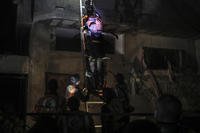The Army plans to spend at least $7 billion over the next five years to develop its new Ground Combat Vehicle and is determined to get a jump on the project, with $934 million slotted for work in 2011 and nearly $2 billion the next year in an accelerated development. The GCV will replace the FCS manned ground vehicles, cancelled last year, as the base model for future combat vehicles; the Army has said the initial variant will be an infantry carrier.
At a briefing to reporters on Monday, Army budget chief Lt. Gen. Edgar Stanton, said the new combat vehicle’s ultimate design is still very much up in the air. Army budget documents released this week also say the new vehicle’s requirements are still being defined.
So where will the GCV money go in 2011? The Army wants builders to begin work on the GCV’s subsystems and modular components, such as the engine, drive train, suspension, armor, turret, weapons, active protection system and a “Mission Module” to carry an infantry squad. Prototypes of the various subsystems are to be ready for testing in early 2012.
To get the process moving, the Army plans to award two competitive contracts in the fourth quarter FY2010. The Army expects builders to use mostly mature technologies in an “evolutionary acquisition approach,” that allows for the “maximum affordable competition” documents say. A subsystem preliminary design review is scheduled for fourth quarter FY2011.
The Army believes a modular assembly approach will facilitate adding technological upgrades, weapons, armor, automotive components and communications networks, over time to the original GCV. How far along the various modular components are in development, their technological “maturity,” will be key to determining which company gets the GCV contract. “Building subsystems early will allow the contractors to validate key and critical portions of their vehicle designs and identify issues that can be addressed early and improve the robustness of the prototype vehicles,” the documents say. It would appear the Army has learned some valuable lessons from the FCS development fiasco.
Building a vehicle that can plug into the Army’s existing and future digital communications, surveillance and sensor architecture to provide soldiers “superior” situational awareness is a Key Performance Parameter (KPP). The vehicle itself will carry a variety of sensors to provide video feeds to crew and the infantry squad. The Army is also looking for a fuel efficient engine to power the GCV.
The GCV will come with a suite of non-lethal weapons in addition to a turret mounted cannon. Survivability against IEDs and mines will factor huge in the vehicle’s design and the hull must survive “Level 1 underbelly threats” and mitigate against “harmful accelerations” to crew and passengers.
Nothing in the budget material about vehicle weight, although there is a reference to “tracks” as a component part, so apparently it will be a tracked infantry fighting vehicle.








